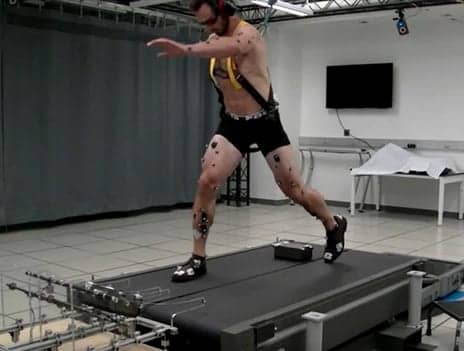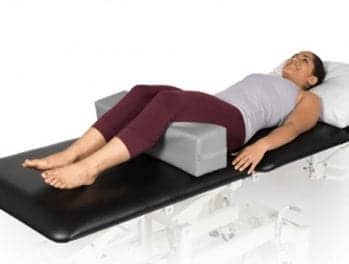
A test subject covered in sensors recovers from a serious stumble on a special treadmill device designed at Vanderbilt University. (Photo courtesy of CREATE at Vanderbilt University)
A research team from Vanderbilt University aims to design better prosthetics by studying how non-amputees recover from stumbles. A study describing their work to capture the stumble response was published recently in the Journal of NeuroEngineering and Rehabilitation.
That automatic stumble response, so natural for most people, is virtually impossible for those who use prosthetic legs, simply because even state-of-the-art prosthetics cannot adapt to stumbling. Patients with above-the-knee amputations are far more likely to fall than typical counterparts in their age group, a media release from Vanderbilt University suggests.
To understand the way people with two legs catch themselves, the team covered test subjects with motion-capturing sensors and tripped them hundreds of times while on a treadmill.
“Not only did our treadmill device have to trip them, it had to trip them at specific points in their gait,” says Shane King, a PhD student and the study’s lead author.
“People stumble differently depending on when their foot hits a barrier. The device also had to overcome their fear of falling, so they couldn’t see or feel when the block was coming.”
In addition to protecting test subjects, the harness included a scale. If a subject put 50% or more of their weight on it, that counted as a fall, the release continues.
Designing the stumble device and measuring outcomes was only the first of three parts, states Michael Goldfarb, H. Fort Flowers Professor of Mechanical Engineering and the study’s principal investigator.
“So now we understand what the stumble reflex should look like,” he shares. “The next phase is to take that information and program it into computer-controlled prosthetic legs. After that, we will safely stumble amputees wearing both commercially available prosthetics and the ones we’ve designed with these reflexes and learn whether ours can prevent more falls.”
The work was performed through the Center for Rehabilitation Engineering and Assistive Technology at Vanderbilt University. Other team members were Karl Zelik, assistant professor of mechanical engineering, and Maura Eveld, a PhD student in mechanical engineerin, per the release.
[Source(s): Vanderbilt University, EurekAlert]




